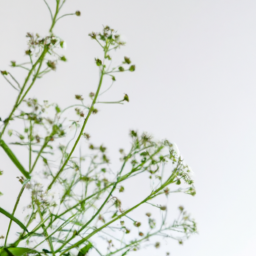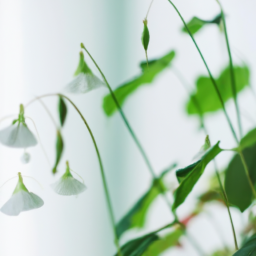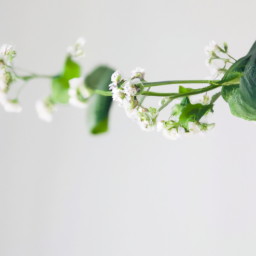
Hey there plant lovers! Are you looking to add a touch of elegance and serenity to your indoor space? Well, look no further because today we are diving into the world of indoor plants with white flowers. These stunning beauties not only bring a sense of calmness and purity to any room, but they also have the power to brighten up even the dullest corners of your home. Whether you have a green thumb or are just starting your plant journey, this blog post will guide you through some of the most popular and easy-to-care-for indoor plants with white flowers. So, let’s get ready to transform your living space into a blooming paradise!
Benefits of Indoor Plants with White Flowers
Introduction
Indoor plants not only add beauty to our living spaces but also offer numerous benefits for our overall well-being. One particular category of indoor plants that stands out is those with white flowers. These elegant and delicate blooms not only enhance the aesthetic appeal of any room but also provide unique advantages that make them a popular choice among plant enthusiasts. In this article, we will explore the various benefits of indoor plants with white flowers and how they can elevate your indoor gardening experience.
Enhance Air Quality
Indoor plants are well-known for their ability to purify the air by removing harmful toxins and pollutants. Plants with white flowers, such as Peace Lily (Spathiphyllum) and Gardenia (Gardenia jasminoides), are particularly effective in improving indoor air quality. These plants have been shown to filter out pollutants like formaldehyde, benzene, and trichloroethylene, which are commonly found in household products and can have detrimental effects on our health. By introducing indoor plants with white flowers into your living space, you can create a healthier and cleaner environment for you and your family.
White flowers are often associated with a fresh and clean aesthetic, which adds to the appeal of these plants. The presence of white blooms can create a sense of tranquility and purity in your home, making it a more peaceful and serene place to relax and unwind.
Boost Mood and Reduce Stress
Indoor plants, including those with white flowers, have been proven to have a positive impact on our mental well-being. The sight of greenery and flowers can uplift our mood, reduce stress levels, and promote a sense of calmness. White flowers, in particular, have a soothing effect on our minds and can help create a serene and peaceful ambiance.
Plants like the White Orchid (Phalaenopsis) and Jasmine (Jasminum) emit a subtle and pleasant fragrance, which can further enhance the mood-enhancing benefits. The delicate scent of white flowers can promote relaxation and alleviate anxiety, making them an excellent choice for bedrooms or any space where you seek tranquility.
Promote Better Sleep
Having trouble sleeping? Indoor plants with white flowers might just be the solution you need. Certain plants release oxygen during the night, making them ideal for bedrooms. The Snake Plant (Sansevieria) and the Peace Lily are two examples of indoor plants with white flowers that release oxygen at night.
In addition to releasing oxygen, these plants also purify the air by removing toxins, which can improve the overall quality of your sleep. The presence of white flowers in your bedroom can create a calming atmosphere and help you unwind before bedtime, promoting a more restful and rejuvenating sleep.
Conclusion
Indoor plants with white flowers offer a myriad of benefits that go beyond their aesthetic appeal. From purifying the air to boosting mood and promoting better sleep, these plants can transform your living spaces into tranquil and healthier environments. Incorporating indoor plants with white flowers into your home not only adds a touch of elegance but also contributes to your overall well-being. So why not bring some of these beautiful plants into your indoor garden and experience the numerous benefits they have to offer?

Popular Varieties of Indoor Plants with White Flowers
Indoor plants with white flowers can add a touch of elegance and serenity to any living space. Whether you have a green thumb or are just starting out as a plant enthusiast, there are several popular varieties that are easy to care for and will brighten up your home. In this guide, we will explore some of the most beloved indoor plants with white flowers, their unique characteristics, and tips for their care.
Pure White Peace Lily
The Peace Lily, scientifically known as Spathiphyllum, is a classic choice for indoor plant lovers. The pure white flowers of this plant symbolize peace and prosperity, making it a perfect addition to any home or office. Peace Lilies are known for their ability to purify the air by filtering out harmful toxins, making them an excellent choice for those with allergies or asthma.
When caring for a Peace Lily, it’s important to keep in mind that they prefer indirect light and slightly moist soil. Avoid overwatering, as this can lead to root rot. These plants thrive in temperatures between 65-80°F (18-27°C) and appreciate a regular misting to increase humidity.
Propagation of Peace Lilies is relatively simple. You can divide the plant during repotting or take stem cuttings and root them in water or a well-draining potting mix. With proper care, your Peace Lily will reward you with stunning white flowers year after year.
Elegant White Orchids
Orchids are known for their exquisite beauty and delicate nature. These stunning plants come in a variety of colors, including white. White orchids symbolize innocence, purity, and elegance, making them a popular choice for weddings and special occasions.
When it comes to caring for white orchids, it’s essential to provide them with the right conditions. They prefer bright, indirect light and should be placed near a window with filtered sunlight. Orchids are epiphytes, which means they grow on other plants rather than in soil. Therefore, it’s crucial to use a well-draining orchid mix or bark to ensure proper drainage.
Watering orchids can be a bit tricky. It’s best to water them thoroughly and allow the roots to dry out slightly before the next watering. Overwatering can lead to root rot, while underwatering can cause the orchid to dry out. Maintaining a humidity level of around 50-70% is also beneficial for these plants. Misting the leaves or using a humidifier can help achieve the desired humidity.
With patience and attention to detail, your white orchids will reward you with their stunning blooms for several weeks or even months.
Fragrant Jasmine
Jasmine plants are treasured for their intoxicating fragrance and delicate white flowers. The Jasmine genus includes several species, but the most commonly grown indoor variety is Jasminum polyanthum. This plant is known for its rapid growth and ability to fill a room with its sweet scent.
When it comes to caring for Jasmine, it’s important to provide it with bright, indirect light. A south or west-facing window is ideal, but be cautious of direct sunlight, as it can scorch the leaves. Jasmine plants prefer well-draining soil and should be watered when the top inch of soil feels dry. They also appreciate high humidity, so misting the leaves or placing a tray of water nearby can be beneficial.
Pruning is essential for Jasmine plants to maintain their shape and encourage bushier growth. You can trim the plant after it finishes blooming to promote new growth and prevent it from becoming leggy.
With proper care and regular pruning, your Jasmine plant will reward you with its heavenly fragrance and beautiful white flowers.
Indoor plants with white flowers bring a sense of purity and serenity to any space. Whether you choose the classic Peace Lily, elegant white orchids, or fragrant Jasmine, these plants will add a touch of beauty to your home. Remember to provide them with the right amount of light, water, and humidity, and they will thrive and brighten up your living environment for years to come.

Care Tips for Indoor Plants with White Flowers
Indoor plants with white flowers can bring a touch of elegance and serenity to any space. Their delicate blooms and lush green foliage can brighten up a room and create a calming atmosphere. However, caring for these plants requires some knowledge and attention. In this guide, we will provide you with step-by-step care tips to ensure your indoor plants with white flowers thrive and flourish.
Choosing the Right Plant
Before diving into the care tips, it’s essential to choose the right indoor plant with white flowers that suits your environment and preferences. Here are a few popular options:
1. Peace Lily (Spathiphyllum wallisii): Peace lilies are known for their elegant white flowers and glossy, dark green leaves. They are relatively easy to care for and can tolerate low light conditions, making them perfect for indoor spaces with limited sunlight.
2. Gardenia (Gardenia jasminoides): Gardenias are prized for their fragrant white flowers and glossy, dark green leaves. They require bright, indirect light and high humidity to thrive. Consider placing them in a bathroom or near a humidifier.
3. Jasmine (Jasminum sambac): Jasmine plants produce small, white, star-shaped flowers that release a sweet fragrance. They prefer bright, indirect light and moderate humidity. Regular pruning will help maintain their shape and promote blooming.
Providing the Right Environment
Indoor plants with white flowers have specific environmental requirements to ensure their well-being. Here’s what you need to consider:
1. Light: Most indoor plants with white flowers thrive in bright, indirect light. Place them near a window with filtered sunlight, but avoid exposing them to direct sunlight, as it can scorch their delicate petals and leaves.
2. Temperature and Humidity: Maintain a consistent temperature range of 60-75°F (15-24°C) for your plants. They generally prefer moderate to high humidity levels, so consider using a humidifier or placing a tray of water near them to increase humidity.
3. Watering: Proper watering is crucial for the health of your indoor plants. Check the moisture level of the soil regularly and water when the top inch feels dry. Avoid overwatering, as it can lead to root rot. Use room temperature water and ensure proper drainage to prevent waterlogging.
4. Fertilization: Indoor plants with white flowers benefit from regular fertilization during the growing season (spring and summer). Use a balanced, water-soluble fertilizer diluted to half the recommended strength. Apply it every 2-4 weeks to provide essential nutrients for healthy growth.
Maintaining and Troubleshooting
To keep your indoor plants with white flowers thriving, you should follow these maintenance tips:
1. Pruning: Regularly prune your plants to remove dead or yellowing leaves, promote bushier growth, and maintain their shape. Use clean, sharp pruning shears and make clean cuts just above a leaf node.
2. Pest Control: Monitor your plants for common pests like aphids, mealybugs, and spider mites. If you notice any infestation, isolate the affected plant and treat it with an appropriate organic insecticide or insecticidal soap.
3. Disease Prevention: Prevent diseases by providing good air circulation and avoiding overwatering. Fungal diseases like powdery mildew can affect indoor plants, so keep an eye out for any signs of infection and address them promptly.
4. Re-potting: As your indoor plants with white flowers grow, they may outgrow their current pots. Consider re-potting them into a slightly larger container with fresh, well-draining potting soil. Spring is the best time for re-potting.
Caring for indoor plants with white flowers can be a rewarding experience. By providing the right environment, regular maintenance, and addressing any issues promptly, you can enjoy the beauty and tranquility these plants bring to your indoor space. Remember to observe your plants closely and adjust their care routine as needed. Happy gardening!
Here are the Essential Points
Indoor plants are a fantastic way to bring nature into your home while adding a touch of elegance and tranquility to your space. If you’re looking for a unique and stunning addition to your indoor garden, why not consider plants with white flowers? These delicate blooms can bring a sense of purity and serenity to any room, creating a soothing atmosphere.
One popular choice is the Peace Lily, known for its glossy green leaves and elegant white flowers. This plant not only adds a touch of beauty to your space but also helps purify the air by removing toxins. Another option is the White Anthurium, with its glossy, heart-shaped leaves and long-lasting white flowers. This plant thrives in low light conditions, making it perfect for those with limited sunlight in their homes. Additionally, the White Orchid is a classic choice, known for its exquisite beauty and graceful presence. With proper care, this plant can bloom for months, adding a touch of luxury to your indoor garden.
FAQ Compilation:
Q1: What are some popular indoor plants with white flowers?
A1: There are several popular indoor plants that feature beautiful white flowers. Some common choices include Peace Lily, Gardenia, Jasmine, Orchids, and African Violets. These plants not only add a touch of elegance to your indoor space but also provide a refreshing and calming atmosphere.
Q2: How do I care for indoor plants with white flowers?
A2: Caring for indoor plants with white flowers is similar to caring for other houseplants. They generally require adequate sunlight, proper watering, and regular fertilization. It’s important to place them in a location with the right amount of light and maintain a consistent watering schedule. Additionally, some plants may benefit from occasional misting to increase humidity.
Q3: Can indoor plants with white flowers survive in low-light conditions?
A3: While some indoor plants with white flowers can tolerate low-light conditions, most of them prefer bright, indirect light. Peace Lily and African Violets are known to be more adaptable to lower light levels, making them suitable for areas with less natural sunlight. However, it’s important to note that even these plants will still require some amount of light to thrive.
Q4: How often should I water indoor plants with white flowers?
A4: The frequency of watering indoor plants with white flowers largely depends on the specific plant and its environment. As a general rule, it’s best to allow the top inch or so of the soil to dry out before watering again. Overwatering can lead to root rot, while underwatering can cause the plant to wilt. It’s always a good idea to check the moisture level of the soil before deciding to water.
Q5: Are indoor plants with white flowers safe for pets?
A5: While many indoor plants with white flowers are safe for pets, some can be toxic if ingested. It’s important to research the specific plant you are interested in and ensure it is pet-friendly. Plants like Peace Lily, African Violets, and Orchids are generally considered safe for pets, but it’s always a good idea to keep them out of reach or consult with a veterinarian if you have concerns.
Dr. Olivia Green is a botanist with over two decades of experience in indoor plant cultivation. She holds a Ph.D. in Plant Biology and has dedicated her career to researching plant behavior in controlled environments. Dr. Green is passionate about helping plant enthusiasts master the art of indoor gardening through her extensive knowledge and practical insights.


